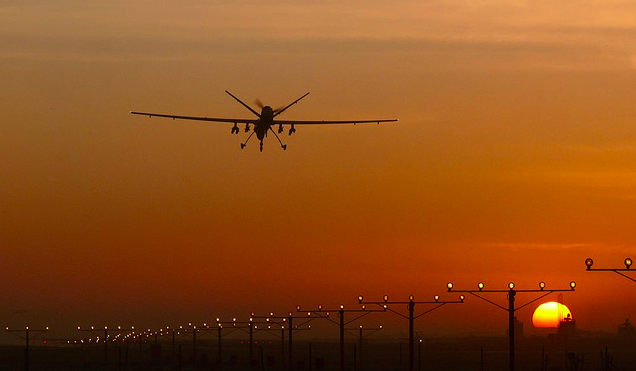 Today is the last day for submissions to the Foreign Affairs, Defence and Trade References Committee inquiry into the potential use by the Australian Defence Force of unmanned air, maritime and land platforms. The Strategist will publish two posts today on armed drones, which together form ASPI's open submission to the Committee.
Today is the last day for submissions to the Foreign Affairs, Defence and Trade References Committee inquiry into the potential use by the Australian Defence Force of unmanned air, maritime and land platforms. The Strategist will publish two posts today on armed drones, which together form ASPI's open submission to the Committee.
When looking at the future shape of the ADF, one of the possible force structure changes the government might chose to make is the addition of armed drones. There are some good reasons for that to happen, but also potential diplomatic downsides that would need to be managed.
Let's start with the case for adding armed drones to the ADF's inventory. There’re two obvious roles for them to play. The first is armed reconnaissance—being able to survey the battlefield and the wider environment, with the ability to engage the enemy if necessary. This is the same role as envisaged for
the Tiger helicopter.
The ADF has already used drones for tactical observation purposes in the form of the small
Shadow that has a wingspan of just over 6 metres and larger
Heron, with a wingspan of 16.6 metres. However neither drone is capable of delivering weapons and any targets identified have to be engaged by other platforms, such as by calling in an air strike. In Afghanistan, the ADF didn't have its own strike platforms in theatre, and relied on armed helicopters and fixed-wing strike aircraft supplied by other coalition nations.
Something like a
Reaper with a Hellfire missile is the obvious option for the time being. They're a weapon that's suited to the operations the ADF has been undertaking in the past decade and a half; against determined but relatively poorly-equipped adversaries such as the Taliban in Afghanistan. By having its own armed drones, Australian forces would have the capability unilaterally to identify and strike targets.
The second application of armed drones is as flying fire support for land force elements that find themselves under fire or otherwise in danger. The long endurance of drones, along with their relatively low cost per flying hour compared to fast jets, makes them a good fit for the role and allows them to be deployed to theatres with relatively limited ability to support flying operations.
In a more contested environment in which the adversary has a sophisticated anti-air capability, something more capable than Reaper would be required. For now, that would likely be a manned strike platform with support from electronic warfare and situational awareness platforms. In the future, there's likely to be higher performance (and almost certainly higher cost) unmanned options such as the stealthy Unmanned Combat Aerial Vehicles under development, such as the
American X-47B and
European Taranis or nEUROn systems.
In fact, when the Defence project that's acquiring Australia's F-35 Joint Strike Fighters was conceived, the final phase allowed for the possibility of acquiring high-performance strike drones if their maturity allowed. They simply aren't yet at a level of technical maturity for that to happen. (And in fact we're still waiting on the F-35 to reach an operational level of capability, but that's another story.) Like all acquisitions, it's a matter of looking at the utility of an armed drone system and comparing it to the cost to make a judgment about its value.
But because of the way that armed drones have entered the public consciousness as weapons in the unconventional part of the 'war on terror', they’ve the potential to draw opposition from the public and from neighbouring governments. In particular, drone strikes in places like Pakistan and Yemen—countries that aren't even declared theatres of conflict—have given them a dark mystique that transcends their actual capability. So if Australia was to purchase Reapers or a similar system, there's the potential to cause alarm, among both Australians and our neighbours. For example, Indonesia might be concerned that Australia was planning to conduct its own strikes against extremist groups on its territory.
There are two things Australia could do to allay those concerns. Firstly, it could make clear public statements about the concept of operations for the drones, limiting them to use in areas where other ADF elements are deployed, for example. Secondly, and perhaps more importantly, the Australian government could ensure that armed drones are put unambiguously and visibly under military control, rather than being 'national assets' in the sense that CIA-operated aircraft that carry out many of the strikes overseas are.
Those constraints wouldn't limit their utility to the ADF, and Australia's intelligence agencies don't have the same operational licence that the CIA has. That's an important difference; the CIA has an operations division (known as the
Special Activities Division) as well as an intelligence division, whereas
Australia's Intelligence Services Act explicitly limits the activities of its foreign intelligence agencies to the collection, analysis and dissemination of intelligence. Military or paramilitary activities are explicitly forbidden, and the use of armed drones by civilian agencies would be a dramatic departure from current practice requiring legislative change.
By making those arrangements clear, the Australian government could ease any regional apprehension about any future acquisition of an armed drone capability. And as Rosie Turner will show in a follow-on post, the UK’s experience in acquiring and using armed drones shows how we might manage the issue.
Andrew Davies is senior analyst for defence capability and director of research at ASPI. Image courtesy of Flickr user UK Ministry of Defence. Print This Post
Print This Post